The NVIDIA GeForce GTX 980 Review: Maxwell Mark 2
by Ryan Smith on September 18, 2014 10:30 PM ESTCompute
On the other hand compared to our Kepler cards GTX 980 introduces a bunch of benefits. Higher CUDA core occupancy is going to be extremely useful in compute benchmarks. So will the larger L2 cache and the 96KB per SMM of shared memory. Even more important, compares to GK104 (GTX 680/770) GTX 980 inherits the compute enhancements that were introduced in GK110 (GTX 780/780 Ti) including changes that relieved pressure on register file bandwidth and capacity. So although GTX 980 is not strictly a compute card – it is first and foremost a graphics card – it has a lot of resources available to spend on compute.
As always we’ll start with LuxMark2.0, the official benchmark of SmallLuxGPU 2.0. SmallLuxGPU is an OpenCL accelerated ray tracer that is part of the larger LuxRender suite. Ray tracing has become a stronghold for GPUs in recent years as ray tracing maps well to GPU pipelines, allowing artists to render scenes much more quickly than with CPUs alone.

Out of the gate GTX 980 takes off like a rocket. AMD’s cards could easily best even GTX 780 Ti here, but GTX 980 wipes out AMD’s lead and then some. At 1.6M samples/sec, GTX 980 Ti is 15% faster than R9 290X and 54% faster than GTX 780 Ti. This, as it’s important to remind everyone, is for a part that technically only has 71% of the CUDA cores of GTX 780 Ti. So per CUDA core, GTX 980 delivers over 2x the LuxMark performance of GTX 780 Ti. Meanwhile against GTX 680 and GTX 780 the lead is downright silly. GTX 980 comes close to tripling its GK104 based predecessors.
I’ve spent some time pondering this, and considering that GTX 750 Ti looked very good in this test as well it’s clear that Maxwell’s architecture has a lot to do with this. I don’t know if NVIDIA hasn’t also been throwing in some driver optimizations here, but a big part is being played by parts of the architecture. GTX 750 Ti and GTX 980 both share the general architecture and 2MB of L2 cache, while it seems like we can run out GTX 980’s larger 96KB shared memory since GTX 750 Ti did not have that. This may just come down to those CUDA core occupancy improvements, especially if you start comparing GTX 980 to GTX 780 Ti.
For our second set of compute benchmarks we have CompuBench 1.5, the successor to CLBenchmark. We’re not due for a benchmark suite refresh until the end of the year, however as CLBenchmark does not know what to make of GTX 980 and is rather old overall, we’ve upgraded to CompBench 1.5 for this review.
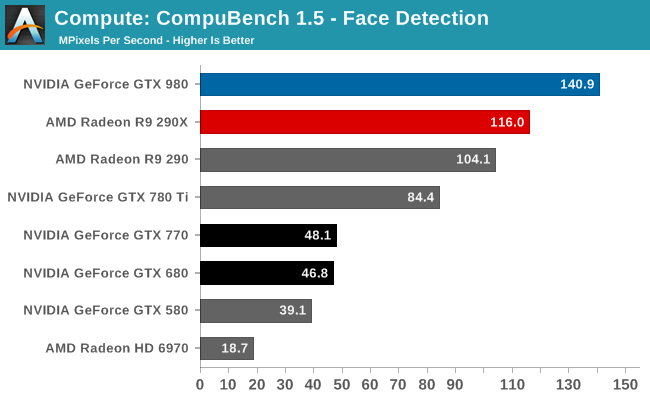
The first sub-benchmark is Face Detection, which like LuxMark puts GTX 980 in a very good light. It’s quite a bit faster than GTX 780 Ti or R9 290X, and comes close to trebling GTX 680.
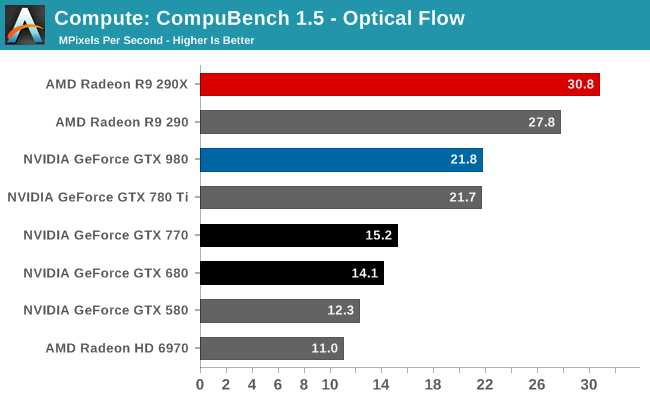
The second sub-benchmark of Optical Flow on the other hand sees AMD put GTX 980 in its place. GTX 980 fares only as well as GTX 780 Ti here, which means performance per CUDA core is up, but not enough to offset the difference in cores. And it doesn’t get GTX 980 anywhere close to beating R9 290X. As a computer vision test this can be pretty memory bandwidth intensive, so this may be a case of GTX 980 succumbing to its lack of memory bandwidth rather than a shader bottleneck.
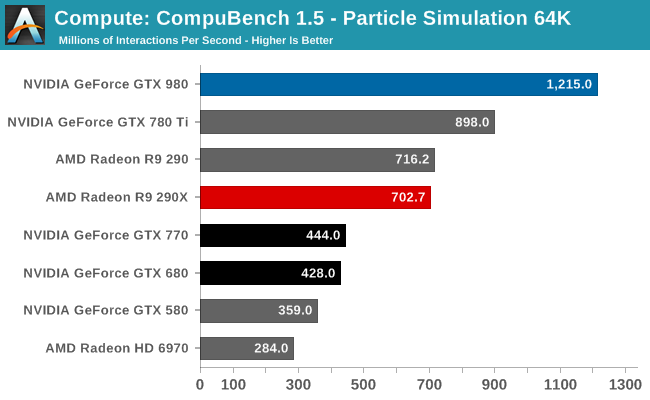
The final sub-benchmark of the particle simulation puts GTX 980 back on top, and by quite a lot. NVIDIA does well in this benchmark to start with – GTX 780 Ti is the number 2 result – and GTX 980 only improves on that. It’s 35% faster than GTX 780 Ti, 73% faster than R9 290X, and GTX 680 is nearly trebled once again. CUDA core occupancy is clearly a big part of these results, though I wonder if the L2 cache and shared memory increase may also be playing a part compared to GTX 780 Ti.
Our 3rd compute benchmark is Sony Vegas Pro 12, an OpenGL and OpenCL video editing and authoring package. Vegas can use GPUs in a few different ways, the primary uses being to accelerate the video effects and compositing process itself, and in the video encoding step. With video encoding being increasingly offloaded to dedicated DSPs these days we’re focusing on the editing and compositing process, rendering to a low CPU overhead format (XDCAM EX). This specific test comes from Sony, and measures how long it takes to render a video.
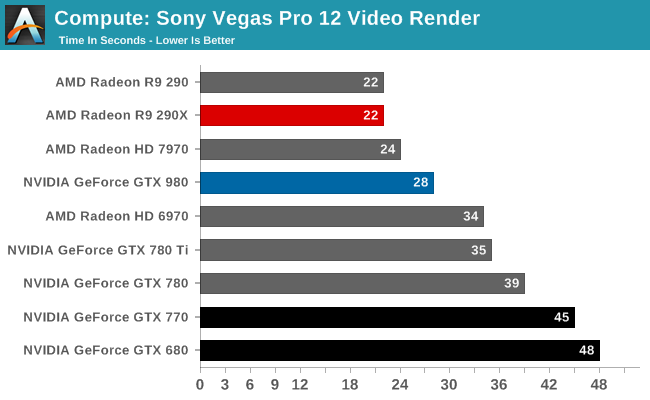
Traditionally a benchmark that favored AMD, the GTX 980 doesn’t manage to beat the R9 290X, but it closes the gap significantly compared to GTX 780 Ti. This test is a mix of simple shaders and blends, so it’s likely we’re seeing a bit of both here. More ROPs for more blending, and improved shader occupancy for when the task is shader-bound.
Moving on, our 4th compute benchmark is FAHBench, the official Folding @ Home benchmark. Folding @ Home is the popular Stanford-backed research and distributed computing initiative that has work distributed to millions of volunteer computers over the internet, each of which is responsible for a tiny slice of a protein folding simulation. FAHBench can test both single precision and double precision floating point performance, with single precision being the most useful metric for most consumer cards due to their low double precision performance. Each precision has two modes, explicit and implicit, the difference being whether water atoms are included in the simulation, which adds quite a bit of work and overhead. This is another OpenCL test, utilizing the OpenCL path for FAHCore 17.
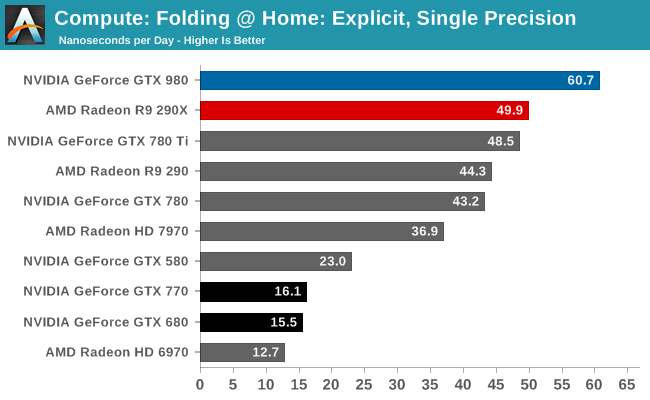
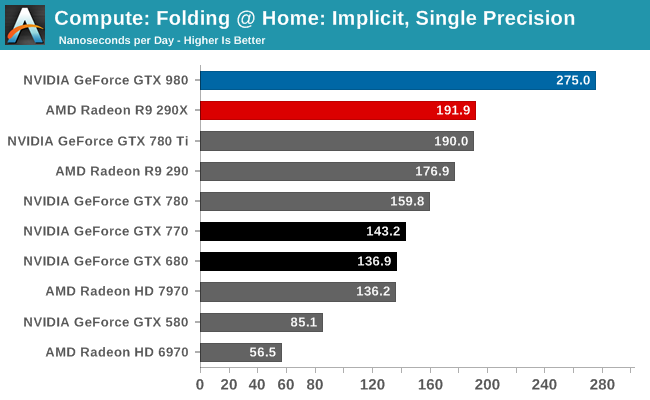
This is another success story for the GTX 980. In both single precision tests the GTX 980 comes out on top, holding a significant lead over the R9 290X. Furthermore we’re seeing some big performance gains over GTX 780 Ti, and outright massive gains over GTX 680, to the point that GTX 980 comes just short of quadrupling GTX 680’s performance in single precision explicit. This test is basically all about shading/compute, so we expect we’re seeing a mix of improvements to CUDA core occupancy, shared memory/cache improvements, and against GTX 680 those register file improvements.

Double precision on the other hand is going to be the GTX 980’s weak point for obvious reasons. GM204 is a graphics GPU first and foremost, so it only has very limited 1:32 rate FP64 performance, leaving it badly outmatched by anything with a better rate. This includes GTX 780/780 Ti (1:24), AMD’s cards (1:8 FP64), and even ancient GTX 580 (1:8). If you want to do real double precision work, NVIDIA clearly wants you buying their bigger, compute-focused products such as GTX Titan, Quadro, and Tesla.
Wrapping things up, our final compute benchmark is an in-house project developed by our very own Dr. Ian Cutress. SystemCompute is our first C++ AMP benchmark, utilizing Microsoft’s simple C++ extensions to allow the easy use of GPU computing in C++ programs. SystemCompute in turn is a collection of benchmarks for several different fundamental compute algorithms, with the final score represented in points. DirectCompute is the compute backend for C++ AMP on Windows, so this forms our other DirectCompute test.

Once again NVIDIA’s compute performance is showing a strong improvement, even under DirectCompute. 17% over GTX 780 Ti and 88% over GTX 680 shows that NVIDIA is getting more work done per CUDA core than ever before. Though this won’t be enough to surpass the even faster R9 290X.
Overall, while NVIDIA can’t win every compute benchmark here, the fact that they are winning so many and by so much – and otherwise not terribly losing the rest – shows that NVIDIA and GM204 have corrected the earlier compute deficiencies in GK104. As an x04 part GM204 may still be first and foremost consumer graphics, but if it’s faced with a compute workload most of the time it’s going to be able to power on through it just as well as it does with games and other graphical workloads.
It would be nice to see GPU compute put to better use than it is today, and having strong(er) compute performance in consumer parts is going to be one of the steps that needs to happen for that outcome to occur.










274 Comments
View All Comments
squngy - Wednesday, November 19, 2014 - link
It is explained in the article.Because GTX980 makes so many more frames the CPU is worked a lot harder. The W in those charts are for the whole system so when the CPU uses more power it makes it harder to directly compare GPUs
galta - Friday, September 19, 2014 - link
The simple fact is that a GPU more powerful than a GTX 980 does not make sense right now, no matter how much we would love to see it.See, most folks are still gaming @ 1080, some of us are moving up to 1440. Under this scenarios, a GTX 980 is more than enough, even if quality settings are maxed out. Early reviews show that it can even handle 4K with moderate settings, and we should expect further performance gains as drivers improve.
Maybe in a year or two, when 4K monitors become more relevant, a more powerful GPU would make sense. Now they simply don't.
For the moment, nVidia's movement is smart and commendable: power efficiency!
I mean, such a powerful card at only 165W! If you are crazy/wealthy enough to have two of them in SLI, you can cut your power demand by 170W, with following gains in temps and/or noise, and and less expensive PSU, if you're building from scratch.
In the end, are these new cards great? Of course they are!
Does it make sense to up-grade right now? Only if you running a 5xx or 6xx series card, or if your demands have increased dramatically (multi-monitor set-up, higher res. etc.).
Margalus - Friday, September 19, 2014 - link
A more powerful gpu does make sense. Some people like to play their games with triple monitors, or more. A single gpu that could play at 7680x1440 with all settings maxed out would be nice.galta - Saturday, September 20, 2014 - link
How many of us demand such power? The ones who really do can go SLI and OC the cards.nVidia would be spending billions for a card that would sell thousands. As I said: we would love the card, but still no sense
Again, I would love to see it, but in the forseeable future, I won't need it. Happier with noise, power and heat efficiency.
Da W - Monday, September 22, 2014 - link
Here's one that demands such power. I play 3600*1920 using 3 screens, almost 4k, 1/3 the budget, and still useful for, you know, working.Don't want sli/crossfire. Don't want a space heater either.
bebimbap - Saturday, September 20, 2014 - link
gaming at 1080@144 or 1080 with min fps of 120 for ulmb is no joke when it comes to gpu requirement. Most modern games max at 80-90fps on a OC'd gtx670 you need at least an OC'd gtx770-780. I'd recommend 780ti. and though a 24" 1080 might seem "small" you only have so much focus. You can't focus on periphery vision you'd have to move your eyes to focus on another piece of the screen. the 24"-27" size seems perfect so you don't have to move your eyes/head much or at all.the next step is 1440@144 or min fps of 120 which requires more gpu than @ 4k60. as 1440 is about 2x 1080 you'd need a gpu 2x as powerful. so you can see why nvidia must put out a powerful card at a moderate price point. They need it for their 144hz gsync tech and 3dvision
imo the ppi race isn't as beneficial as higher refresh rate. For TVs manufacturers are playing this game of misinformation so consumers get the short end of the stick, but having a monitor running at 144hz is a world of difference compared to 60hz for me. you can tell just from the mouse cursor moving across the screen. As I age I realize every day that my eyes will never be as good as yesterday, and knowing that I'd take a 27" 1440p @ 144hz any day over a 28" 5k @ 60hz.
Laststop311 - Sunday, September 21, 2014 - link
Well it all depends on viewing distance. I use a 30" 2560x1600 dell u3014 to game on currently since it's larger i can sit further away and still have just as good of an experience as a 24 or 27 thats closer. So you can't just say larger monitors mean you can;t focus on it all cause you can just at a further distance.theuglyman0war - Monday, September 22, 2014 - link
The power of the newest technology is and has always been an illusion because the creation of games will always be an exercise in "compromise". Even a game like WOW that isn't crippled by console consideration is created by the lowest common denominator demographic in the PC hardware population. In other words... ( if u buy it they will make it vs. if they make it I will upgrade ). Besides the unlimited reach of an openworld's "possible" textures and vtx counts."Some" artists are of the opinion that more hardware power would result in a less aggressive graphic budget! ( when the time spent wrangling a synced normal mapped representation of a high resolution sculpt or tracking seam problems in lightmapped approximations of complex illumination with long bake times can take longer than simply using that original complexity ). The compromise can take more time then if we had hardware that could keep up with an artists imagination.
In which case I gotta wonder about the imagination of the end user that really believes his hardware is the end to any graphics progress?
ppi - Friday, September 19, 2014 - link
On desktop, all AMD needs to do is to lower price and perhaps release OC'd 290X to match 980 performance. It will reduce their margins, but they won't be irrelevant on the market, like in CPUs vs Intel (where AMD's most powerful beasts barely touch Intel's low-end, apart from some specific multi-threaded cases)Why so simple? On desktop:
- Performance is still #1 factor - if you offer more per your $, you win
- Noise can be easily resolved via open air coolers
- Power consumption is not such a big deal
So ... if AMD card at a given price is as fast as Maxwell, then they are clearly worse choice. But if they are faster?
In mobile, however, they are screwed big way, unless they have something REAL good in their sleeve (looking at Tonga, I do not think they do, as I am convinced AMD intends to pull off another HD5870 (i.e. be on the new process node first), but it apparently did not work this time around.)
Friendly0Fire - Friday, September 19, 2014 - link
The 290X already is effectively an overclocked 290 though. I'm not sure they'd be able to crank up power consumption reliably without running into heat dissipation or power draw limits.Also, they'd have to invest in making a good reference cooler.